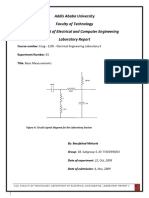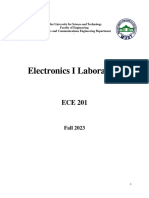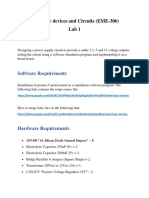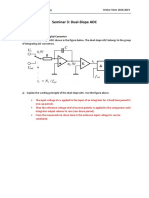Lab Manual: EGCI 232 Engineering Electronics
Lab Manual: EGCI 232 Engineering Electronics
Uploaded by
gapswitCopyright:
Available Formats
Lab Manual: EGCI 232 Engineering Electronics
Lab Manual: EGCI 232 Engineering Electronics
Uploaded by
gapswitOriginal Description:
Original Title
Copyright
Available Formats
Share this document
Did you find this document useful?
Is this content inappropriate?
Copyright:
Available Formats
Lab Manual: EGCI 232 Engineering Electronics
Lab Manual: EGCI 232 Engineering Electronics
Uploaded by
gapswitCopyright:
Available Formats
Lab Manual
EGCI 232 Engineering Electronics
Academic Year 2020-2021
Lab Overview
The field of Electronics Engineering is characterized by rapid and continuous evolution both in
philosophy and technology. Among the tools needed for manpower development, the lab manual
plays a vital role. Textbooks written on analytical themes in electronics engineering provide
theoretical foundation, but lab manuals presenting the practical systems are required to develop
intellectual and motor skills in young diploma engineers.
Low voltage requirements of electronic devices and their ability to control high power electrical
equipment made the use of electronic devices in electrical industries more prominent. With the
evolution of integrated circuits the space requirement is also reduced. The electronic control is more
superior to other control methods with respect to cost, reliability, maintenance and controlling
power. Therefore study of basic electronic components will provide the supporting tools for
electrical control industry.
Objectives:
1. Understand the basic principles of electronic devices.
2. Identify and specify various electronic components and devices.
3. Understand the construction and working principles of different electronic devices.
4. Understand the use of different electronic devices.
Contents:
Lab 1: Diode Circuits
Lab 2: Bipolar Junction Transistor Amplifiers
Lab 3: Field Effect Transistor Amplifiers
Lab 4: Differential Amplifiers
Lab 5: Operational Amplifiers
EGCI 232 Engineering Electronics (Lab Manual Ed.5th) Page 1
Introduction to Lab Equipments
Basic equipments in electronic laboratory are power supply, function generator, oscilloscope
multimeter, and breadboard. Power supply generates variable DC voltages for circuits. Function
generator generates signal in different form with variable amplitude and frequency. Oscilloscope
measures the voltage and frequency of an electric signal, and provides visual image of the signal on
display. Multimeter is basic measuring equipment for electrical properties. And, breadboard or
protoboard is a construction base for an electronic circuit.
(a) Power Supply (b) Function Generator
(c) Oscilloscope (d) Multimeter(e) Breadboard
Fig. 1.1Equipments in Electronic Laboratory
Each workstation in the lab has the necessary equipment: an oscilloscope, a power supply, an analog
multimeter and an experimental box. The multimeter can measure voltage, current, resistance and
capacitance. The experimental box includes ±5 V and ±12 V power supplies, breadboard, and a
function generator, which is sufficient for experiments.
The breadboarding area, as shown in Fig. 1.2, on the experimental box has holes for component leads
and IC pins. The right size of wires are needed otherwise the board will be ruined. The horizontal
rows of holes on the top and bottom of the breadboard are connected together horizontally. The left
and right halves are independent. We suggest that youuse these horizontal rows for power supply
EGCI 232 Engineering Electronics (Lab Manual Ed.5th) Page 2
voltages and ground. You may wish to put a jumperwire between the left and right halves so that the
voltages are the same across the board. Thevertical columns of holes are connected electrically in
groups of five along a vertical line. The topand bottom halves are independent. Typically one inserts
an IC chip straddling the center through.
There are then four empty holes for making connections to each IC pin. When you plug IC's intothe
breadboard, a common convention is to put pin 1 on the left. For other components, makesure the
leads are not in the same column of five unless you want them connected together.
Fig. 1.2 TheBreadboard Area
The oscilloscope has many knobs and buttons which may be confusing at first. It helps if you read the
introductory booklet and manual provided by Tektronix. If nothing seems to be happening press
AUTOSET.
Fig. 1.3 Oscilloscope
EGCI 232 Engineering Electronics (Lab Manual Ed.5th) Page 3
Lab 1: Diode Circuits
Apparatus List Quantity
1. Diodes :
1N4001 4
2. Resistors:
1kΩ 1
4.7kΩ 1
10kΩ 1
22kΩ 1
3. Capacitors:
470 μF/50V 1
220 μF/50V 1
4. Transformer 220/12V 1
5. IC Regulator 7805 1
6. Oscilloscope 1
7. Power supply 1
1.1 Characteristics of PN junction diode
Lab procedure
E VR1 R1 E VR1 R1
10V 10V
VD1 D1 VD1 D1
(a) Forward bias (b) Reverse bias
Fig. 1.1 Diode Circuits
1. Build a forward biased diode circuit as shown in Fig.1.1 (a).
2. Measure voltage across the diode and voltage across the resistor. Record experimental
results in Table 1.1(a).
3. Repeat the previous procedure with different resistors according to Table 1.1.
4. Build a reverse biased diode circuit as shown in Fig.1.1 (b).
5. Measure voltage across the diode and voltage across resistor. Record experimental results in
Table 1.1(b).
6. Repeat the previous procedure with different resistors.
7. Plot I-V characteristic curve of diode from the experiment results.
EGCI 232 Engineering Electronics (Lab Manual Ed.5th) Page 4
Table 1.1
R() 22k 10k 4.7k 1k
VD1
Forward
Bias VR1
VD1
Reverse
Bias VR1
I-V Characteristic Curve
1.2Bridge Rectifier and Power Supply
Lab procedure
Safety caution: AC 220V is used in the experiment. Be careful with the circuit connections.
(a) Bridge Rectifier
(b) Power Supply
Fig. 1.2Bridge Rectifier and Power Supply
EGCI 232 Engineering Electronics (Lab Manual Ed.5th) Page 5
1. Build a bridge rectifier circuit as shown in Fig. 1.2(a).Do not plug in the transformer until you
are sure about circuit connection.
2. Use oscilloscope to obtain voltage
across RL. Sketch the waveform.
3. Connect a capacitor of 220 μF across RL. Use oscilloscope in AC mode to obtain voltage
across RL. Sketch the waveform.
4. Connect a capacitor of 470 μF across RL. Use oscilloscope in AC mode to obtain voltage
across RL. Sketch the waveform and compare with the result from 3.
5. Build a power supply circuit as shown in Fig. 1.3(b). Do not plug in the transformer until you
are sure about circuit connection.
6. Use oscilloscope in DC mode to obtain voltage across RL. Output voltage across the load
resistance (Vout) is _______________.
EGCI 232 Engineering Electronics (Lab Manual Ed.5th) Page 6
Lab 2: Bipolar Junction Transistor Amplifier
Apparatus List Quantity
1. Transistors 2N2222A 1
2. Resistors: 1kΩ 2
10kΩ 2
2.2 kΩ 1
3.9kΩ 1
5.6 kΩ 1
3. Capacitors:1μF/50V 2
10 μF/50V 1
4. Oscilloscope 1
5. Power supply 1
6. Function generator 1
2.1 Fully Bypassed Common-Emitter Amplifier
Labprocedure
Fig. 2.1 Common-Emitter Amplifier (Fully Bypassed)
1. Build a common-emitter amplifier as shown in Fig. 2.1 (ignore RL). Do not turn on the function
generator.
2. Measure bias voltages and find transistor currents.Record the results as followed.
VR1 ______ V ; VR2 ______ V ; VRC _______ V ; VCE _______ V
VR1 VR2 VRE VRC
IB _______ ; I E _______ ; I C _______
R1 R2 RE RC
EGCI 232 Engineering Electronics (Lab Manual Ed.5th) Page 7
(Continued)
3. Apply sinusoidal signal, vs, of 1 kHz from function generator to the amplifier circuit. Adjust
the amplitude of vsuntil the output signal is 1 Vp-p.
4. Use oscilloscope to obtain input signal, vin, and find voltage gain (Avo). Sketch the input and
output signal waveforms and record the experimental results in Table 2.1(a).
5. Add load resistance, RL, to the output of amplifier then repeat the experiment. Record the
experimental results in Table 2.1(b).
6. Find input resistance of the amplifier and explain.
Table 2.1Fully bypassed common-emitter amplifier
(a) Open load RL (b) IncludingRL = 5.6 kΩ
vo vo
v o V p p vin V p p Avo v o V p p Av
vin vin
1 1
2.2UnbypassedCommon-Emitter Amplifier
Labprocedure
1. Build a common-emitter amplifier as shown in Fig. 2.2 (ignore RL). Do not turn on the function
generator.
2. Apply sinusoidal signal, vs, of 1 kHz from function generator to the amplifier circuit. Adjust
the amplitude of vs until the output signal is 1 Vp-p.
EGCI 232 Engineering Electronics (Lab Manual Ed.5th) Page 8
3. Use oscilloscope to obtain input signal, vin, and find voltage gain (Avo). Sketch the input and
output signal waveforms and record theexperimental results in Table 2.2(a).
4. Add load resistance, RL, to the output of amplifier then repeat the experiment. Record the
experimental results in Table 2.2(b).
Fig. 2.2 Common-Emitter Amplifier (Unbypassed)
Table 2.2 Unbypassed common-emitter amplifier
(a) Open load RL (b) IncludingRL = 5.6 kΩ
vo vo
v o V p p vin V p p Avo v o V p p Av
vin vin
1 1
Lab 3: Field Effect Transistor Amplifiers
Apparatus List Quantity
N-Channel
1. 1
JFET2N5459or2N3819
2. Resistors: 2.7kΩ 1
4.7kΩ 1
EGCI 232 Engineering Electronics (Lab Manual Ed.5th) Page 9
10kΩ 1
100 kΩ 1
1 MΩ 1
3. Capacitors:0.1μF/50V 1
10 μF/50V 1
4. Multimeter 1
5. Oscilloscope 1
6. Power supply 1
7. Function generator 1
3.1 Common-
Source Amplifier
Fig. 3.1 Common-Source Amplifier
Labprocedure
1. Build a common-emitter amplifier as shown in Fig. 3.1.Do not turn on function generator.
2. Measure dc voltages at the points VG, VS, VD, and VGS. Calculate the current ID and record the
experimental results in Table 3.1(a). (Note: For all measurements, the voltmeter or
oscilloscope has to be set at DC mode.)
3. Apply sinusoidal signal,vs, from a function generator so that input voltage, vi, is 500 mVp-p at
1 kHz.
4. Use oscilloscope to measure input signal (vi) on channel 1 and output signal (vout)on channel 2.
Record the amplitude of both voltages in Table 3.1(b)and sketch both waveforms.
5. Find voltage gain AV.
6. Find input resistance Zinand compare it to the theoretical one. (While measureingvi, the
oscilloscope has to be set in AC mode.)
(Continued)
EGCI 232 Engineering Electronics (Lab Manual Ed.5th) Page 10
7. Take C3 out and measure vout with vin = 500 mVP-P. Record the experimental results in Table 3.1
(c).
8. Sketch a waveform and calculate voltage gain AV
Table 3.1
(a) Bias (b) Small-Signal (Bypassed) (c) Small-Signal (Unbypassed)
VG VS VD VGS ID= Vs / Rs vin vout AV v1 = vin - vi Zin vout AV
500 mV
EGCI 232 Engineering Electronics (Lab Manual Ed.5th) Page 11
Lab 4: Differential Amplifier
Apparatus List Quantity
1. Transistors 2N2222A 4
2. Resistors: 10kΩ 2
15kΩ 2
22 kΩ 2
56kΩ 2
3. Capacitors:1μF/50V 2
4.7μF/50V 2
4. Oscilloscope 1
5. Power supply 1
6. Function generator 1
Labprocedure
Fig. 4 Differential Amplifier with Current Source
1. Build a differential amplifier circuit as shown in Fig. 4. In this circuit, Q3 and Q4 acting like
constant current source (current mirror), which are used for biasing. More importantly, Q1
has to be matched with Q2, and Q3 has to be matched with Q4.
2. Apply a 100 mVp-psinusoidal input signal vi1 with a frequency of 1 kHz while vi2 is put to
ground.
EGCI 232 Engineering Electronics (Lab Manual Ed.5th) Page 12
3. Measure the vo1, vo2, and differential mode voltage gain Adm. Record the experimental results
in Table 4(a).
4. Apply a 5Vp-p sinusoidal signal with a frequency 1 kHz to bothvi1 and vi2.
(Continued)
5. Measure the vo1, vo2, and common mode voltage gain Acm. Record the experimental results in
Table 4(b) and calculate CMRR.
Table 4
(a) Differential mode (b) common mode CMRR
vin1 vo1 vo2 Adm vin1 vo1 vo2 Acm
Lab 5: Operational Amplifiers
Apparatus List Quantity
1. Op-Amp 741 1
2. Resistors: 1kΩ 1
10kΩ 2
56kΩ 1
100kΩ 1
3. Multimeter 1
4. Oscilloscope 1
5. Power supply 1
6. Function generator 1
5.1 Non-inverting Amplifier
Labprocedure
Fig. 5.1Non-inverting Amplifier
EGCI 232 Engineering Electronics (Lab Manual Ed.5th) Page 13
1. Build a non-inverting amplifier circuit as shown in Fig. 5.1.
2. With sinusoidal input signal of 1Vp-p at 1 kHz, use oscilloscope to measureV0at different
feedback resistors, Rf, according to Table 5.1.
3. With each Rf, record the amplitude and phase of V0, andcalculate the voltage gain (Av)in
Table 5.1.
(Continued)
4. Compare the experimental results with theoretical results.
Table 5.1
RF 0Ω 10 kΩ 56 kΩ 100 kΩ
V0
AV
Phase
5.2Inverting Amplifier
Labprocedure
Fig. 5.2 Inverting Amplifier
1. Build a non-inverting amplifier circuit as shown in Fig. 5.2.
2. With sinusoidal input signal of 1Vp-p at 1 kHz, use oscilloscope to measureV0at different
feedback resistors, Rf, according to Table 5.2.
3. With each Rf, record the amplitude and phase of V0, andcalculate the voltage gain (Av) in
Table 5.2.
4. Compare the experimental results with theoretical results.
Table 5.2
RF 0Ω 10 kΩ 56 kΩ 100 kΩ
V0
AV
Phase
EGCI 232 Engineering Electronics (Lab Manual Ed.5th) Page 14
EGCI 232 Engineering Electronics (Lab Manual Ed.5th) Page 15
Datasheet:
EGCI 232 Engineering Electronics (Lab Manual Ed.5th) Page 16
EGCI 232 Engineering Electronics (Lab Manual Ed.5th) Page 17
EGCI 232 Engineering Electronics (Lab Manual Ed.5th) Page 18
EGCI 232 Engineering Electronics (Lab Manual Ed.5th) Page 19
EGCI 232 Engineering Electronics (Lab Manual Ed.5th) Page 20
EGCI 232 Engineering Electronics (Lab Manual Ed.5th) Page 21
EGCI 232 Engineering Electronics (Lab Manual Ed.5th) Page 22
EGCI 232 Engineering Electronics (Lab Manual Ed.5th) Page 23
EGCI 232 Engineering Electronics (Lab Manual Ed.5th) Page 24
EGCI 232 Engineering Electronics (Lab Manual Ed.5th) Page 25
You might also like
- 1000 2000 4th Gen Wiring SchematicDocument1 page1000 2000 4th Gen Wiring SchematicObed bracamontes0% (2)
- Lab Report 1Document7 pagesLab Report 1Yohannes Alemayehu100% (1)
- Communication Solved ProblemsDocument145 pagesCommunication Solved ProblemsAngel Linton50% (4)
- ELET 211 Lab Manual 2022Document125 pagesELET 211 Lab Manual 2022Ahmad ManaNo ratings yet
- Lab2 Report 1620660042Document21 pagesLab2 Report 1620660042Nafiz SheikhNo ratings yet
- DEVICE EXP 2 Student - 2Document4 pagesDEVICE EXP 2 Student - 2Pablo ChanNo ratings yet
- Device Exp 2 Student ManualDocument4 pagesDevice Exp 2 Student Manualgg ezNo ratings yet
- EEE111 - Lab ManualDocument28 pagesEEE111 - Lab ManualAnindita MishiNo ratings yet
- Lab Report 2Document7 pagesLab Report 2Yohannes AlemayehuNo ratings yet
- Electronics I (EECE 3110) Lab 5: MosfetsDocument9 pagesElectronics I (EECE 3110) Lab 5: Mosfetswaqas akramNo ratings yet
- Electronics Device Circuit Lab SheetDocument27 pagesElectronics Device Circuit Lab Sheetjimfinch512No ratings yet
- 555ic Timer ManualDocument17 pages555ic Timer Manualvineetmohite18No ratings yet
- EE-252-Electronic Devices & Digital Electronics Laboratory Manual/ RecordDocument85 pagesEE-252-Electronic Devices & Digital Electronics Laboratory Manual/ RecordkishorebabNo ratings yet
- Other 22122021211053993Document6 pagesOther 22122021211053993Dhrubajit Acharya Bishal 222-15-6242No ratings yet
- 1 - 4 CSE Odd Sem 19.08.2019.Doc.XDocument43 pages1 - 4 CSE Odd Sem 19.08.2019.Doc.XNagarjun ReddyNo ratings yet
- Lic Lab ManualDocument49 pagesLic Lab ManualJaronNo ratings yet
- EEE2045F Diode PracticalDocument6 pagesEEE2045F Diode PracticaljaconlateNo ratings yet
- 1.) CE AmplifierDocument4 pages1.) CE AmplifierJuay Mae RianoNo ratings yet
- Expt 5 - Wein Bridge Oscillator (2020)Document3 pagesExpt 5 - Wein Bridge Oscillator (2020)samarthNo ratings yet
- Lab Report 1Document7 pagesLab Report 1minasetilayeeNo ratings yet
- Diode Clippers and ClampersDocument3 pagesDiode Clippers and ClampersPraveen KNo ratings yet
- ECA ManualDocument50 pagesECA ManualkrajenderreddyNo ratings yet
- Eee BEE BEEE LAB MANUAL 10122019Document36 pagesEee BEE BEEE LAB MANUAL 10122019ale aleNo ratings yet
- EC6361 Electronics LaboratoryDocument97 pagesEC6361 Electronics LaboratoryBaskarNo ratings yet
- Lab Report 4Document8 pagesLab Report 4Yohannes AlemayehuNo ratings yet
- Multi-Stage Amplifier: Lab 6 Salvatore D'Acunto 8508-8811 04/20/2011Document11 pagesMulti-Stage Amplifier: Lab 6 Salvatore D'Acunto 8508-8811 04/20/2011Salvatore D'AcuntoNo ratings yet
- EEW Lab Manual - FinalDocument51 pagesEEW Lab Manual - FinaljeniferNo ratings yet
- C-20 P e Practicle ComletetDocument80 pagesC-20 P e Practicle Comletetamrutha cNo ratings yet
- Electronics I Lab. ECE 201Document40 pagesElectronics I Lab. ECE 201ajf3215No ratings yet
- Bec3l1 - Edc Lab NewDocument55 pagesBec3l1 - Edc Lab NewAhyen TambongNo ratings yet
- Al Aboosi ClapSwitchwithlightDesignDocument12 pagesAl Aboosi ClapSwitchwithlightDesignBrijesh BunnyNo ratings yet
- Lab 8 Report Electronics 1Document13 pagesLab 8 Report Electronics 1Dawn J. OwensNo ratings yet
- Full Wave Rectifier Circuit Lab ManualDocument3 pagesFull Wave Rectifier Circuit Lab ManualMohammadNo ratings yet
- 5.) Common Drain AmplifierDocument5 pages5.) Common Drain AmplifierJuay Mae Riano100% (1)
- Analog System Design ExperimentsDocument27 pagesAnalog System Design ExperimentsAnsh BhaganiaNo ratings yet
- Sitam Aica Exp-12-Vco 566Document2 pagesSitam Aica Exp-12-Vco 566kilarisuribabu666No ratings yet
- Lab Manual Ece150Document15 pagesLab Manual Ece150Atul SainiNo ratings yet
- ECCE4466: Power Electronics Student Lab Manual: Department of Electrical and Computer EngineeringDocument20 pagesECCE4466: Power Electronics Student Lab Manual: Department of Electrical and Computer Engineeringsenpai_mendozaNo ratings yet
- Name: Date:: Experiment 02 Common Base AmplifierDocument3 pagesName: Date:: Experiment 02 Common Base AmplifierJuay Mae Riano50% (2)
- Experiment 04 Common Source Amplifier Name: DateDocument5 pagesExperiment 04 Common Source Amplifier Name: DateJuay Mae RianoNo ratings yet
- Colpitts OscillatorDocument5 pagesColpitts OscillatorVARAPRASADNo ratings yet
- ECD Lab 7 BobDocument15 pagesECD Lab 7 Bobfolkbunny1No ratings yet
- Experiment 1Document4 pagesExperiment 1Swaroop MallickNo ratings yet
- Experiment No 6 Difference AmplifierDocument2 pagesExperiment No 6 Difference AmplifierHaytham KenwayNo ratings yet
- IE Lab Report 9Document15 pagesIE Lab Report 9priyanshukrguptapkgNo ratings yet
- Ec8462-Linear Integrated Circuits Lab-1430566332-Ec 8462 Lic Lab ManualDocument54 pagesEc8462-Linear Integrated Circuits Lab-1430566332-Ec 8462 Lic Lab Manualnagadeepa2310No ratings yet
- Electronic Devices Circuits (Edc) Laboratory Manual: For Ii / Iv B.E (Ece) : I - SemesterDocument80 pagesElectronic Devices Circuits (Edc) Laboratory Manual: For Ii / Iv B.E (Ece) : I - SemesterDominic BoseNo ratings yet
- 3rd Semester Lab 2019Document36 pages3rd Semester Lab 2019Noor HussainNo ratings yet
- 3rd Semester Lab 201Document36 pages3rd Semester Lab 201Noor HussainNo ratings yet
- Electronic Devices and Circuits (EME-306) Lab 1: ObjectiveDocument7 pagesElectronic Devices and Circuits (EME-306) Lab 1: ObjectiveAhmed SayedNo ratings yet
- Basic Electronics Laboratory LatestDocument54 pagesBasic Electronics Laboratory LatestBhargobi RoyNo ratings yet
- Ec8311 Electronics Laboratory 490528441 Ec8311 Electronics Laboratory ManualDocument97 pagesEc8311 Electronics Laboratory 490528441 Ec8311 Electronics Laboratory ManualSaranya DeviNo ratings yet
- Name: Date:: Experiment 03 Common Collector AmplifierDocument3 pagesName: Date:: Experiment 03 Common Collector AmplifierJuay Mae RianoNo ratings yet
- PH 411 Physics Laboratory I (Electronics) : Instruction Manual IndexDocument28 pagesPH 411 Physics Laboratory I (Electronics) : Instruction Manual IndexReddyvari VenugopalNo ratings yet
- Ee 262 ManualsDocument23 pagesEe 262 ManualsSahithi GaddipatiNo ratings yet
- Electronics Laboratory and Students' Kits For Self-Study and Distant LearningDocument23 pagesElectronics Laboratory and Students' Kits For Self-Study and Distant LearningSahibaNo ratings yet
- IPCC EPC Lab Manual-2023 - 231117 - 094512 (1) - 231120 - 121052Document79 pagesIPCC EPC Lab Manual-2023 - 231117 - 094512 (1) - 231120 - 121052Pratheeksha MuraliNo ratings yet
- EXP NO-3Document8 pagesEXP NO-3Er.Utpal Kumar PaulNo ratings yet
- ELET 201 - Basic Industrial Electronics - Lab Manual - 2023Document140 pagesELET 201 - Basic Industrial Electronics - Lab Manual - 2023bandr almalkiNo ratings yet
- Electromagnetic Compatibility (EMC) Design and Test Case AnalysisFrom EverandElectromagnetic Compatibility (EMC) Design and Test Case AnalysisNo ratings yet
- Design of Electrical Circuits using Engineering Software ToolsFrom EverandDesign of Electrical Circuits using Engineering Software ToolsNo ratings yet
- HW - 2 Ch#3 - Model and OpAmpDocument2 pagesHW - 2 Ch#3 - Model and OpAmpgapswitNo ratings yet
- Definition and Terminology ProblemsDocument2 pagesDefinition and Terminology ProblemsgapswitNo ratings yet
- A Short Presentation 2014 PDFDocument28 pagesA Short Presentation 2014 PDFgapswitNo ratings yet
- Compare Sorting Algorithms in C LanguageDocument12 pagesCompare Sorting Algorithms in C LanguagegapswitNo ratings yet
- A Short Presentation 2014 PDFDocument28 pagesA Short Presentation 2014 PDFgapswitNo ratings yet
- LEGO Responsibility Report 2016Document80 pagesLEGO Responsibility Report 2016gapswitNo ratings yet
- Human Rights in BangladeshDocument13 pagesHuman Rights in BangladeshgapswitNo ratings yet
- Alfanar Alf Wiring Accessories CatalogDocument6 pagesAlfanar Alf Wiring Accessories CatalogMystic AamirNo ratings yet
- JVC LCD Lt-19d200Document74 pagesJVC LCD Lt-19d200ngoclinhdtddNo ratings yet
- Experiment 3 - Part I: Design of An Experimental SetupDocument13 pagesExperiment 3 - Part I: Design of An Experimental SetupMostafaDilatyNo ratings yet
- 901 Exam QuestionsDocument45 pages901 Exam QuestionsmasterguardianNo ratings yet
- Varactor AssignmentDocument9 pagesVaractor Assignmentjawad_h89No ratings yet
- LCD Panel Scan System Signal DiscriptionDocument4 pagesLCD Panel Scan System Signal DiscriptionsuryajavedNo ratings yet
- Industrial Automation Part 2Document10 pagesIndustrial Automation Part 2Eamin Ch100% (1)
- Gallun and Hafter (2006)Document13 pagesGallun and Hafter (2006)Ruba BANo ratings yet
- Chapter 3: Solid-State Diodes and Diode CircuitsDocument17 pagesChapter 3: Solid-State Diodes and Diode CircuitsLê Hoàng ChínhNo ratings yet
- C FGSW 2622vhpv3 LDocument7 pagesC FGSW 2622vhpv3 LAlexandra RamónNo ratings yet
- Pe - 1966-04Document116 pagesPe - 1966-04Anonymous kdqf49qbNo ratings yet
- Zigbee Networks: Frequently Asked QuestionsDocument4 pagesZigbee Networks: Frequently Asked QuestionsVinzoKeiNo ratings yet
- History of BSNL and Operational Services With New Management FromDocument5 pagesHistory of BSNL and Operational Services With New Management FromJay ParekhNo ratings yet
- Fully Reused VLSI Architecture of FMO/Manchester Encoding Using SOLS Technique For DSRC ApplicationsDocument16 pagesFully Reused VLSI Architecture of FMO/Manchester Encoding Using SOLS Technique For DSRC ApplicationssnehaNo ratings yet
- Ec8011 DSP Processor Architecture and Programming: Diploma, Anna Univ UG & PG CoursesDocument2 pagesEc8011 DSP Processor Architecture and Programming: Diploma, Anna Univ UG & PG Coursespriyaa darshniNo ratings yet
- System Components: Separating and Protective InstrumentsDocument10 pagesSystem Components: Separating and Protective InstrumentsOtavioNo ratings yet
- Iot Based Smart Farming System: A Project ReportDocument18 pagesIot Based Smart Farming System: A Project ReportKissan PortalNo ratings yet
- Applied Electrical Notes Unit 1Document12 pagesApplied Electrical Notes Unit 1The STUDY koala happyNo ratings yet
- DSP WT1819 Seminar 3 Solution PDFDocument4 pagesDSP WT1819 Seminar 3 Solution PDFTalal AhmadNo ratings yet
- Product Specification: Final SpecificationsDocument35 pagesProduct Specification: Final SpecificationsIon PetruscaNo ratings yet
- Channel Estimation For Intelligent Reflecting Surface Assisted Multiuser Communications Framework Algorithms and AnalysisDocument14 pagesChannel Estimation For Intelligent Reflecting Surface Assisted Multiuser Communications Framework Algorithms and AnalysisPillala MuraliNo ratings yet
- CO2038 Lab4Document18 pagesCO2038 Lab427-Lục Tấn Phúc-11A8No ratings yet
- Zigbee Based Wireless Scada System: Bachelor of Engineering in Electronics & Telecommunication EngineeringDocument43 pagesZigbee Based Wireless Scada System: Bachelor of Engineering in Electronics & Telecommunication EngineeringSaurabhNo ratings yet
- Low Density Parity Check Codes1Document41 pagesLow Density Parity Check Codes1Prithvi RajNo ratings yet
- Site Test Report Date: Al-Osais Co. KHUDARIYAH S/S 115/13.8 KV S/S CT Supervision Relay - MVTPDocument4 pagesSite Test Report Date: Al-Osais Co. KHUDARIYAH S/S 115/13.8 KV S/S CT Supervision Relay - MVTPsikander843562No ratings yet
- Midos: Type MVAJ Tripping and Control RelaysDocument10 pagesMidos: Type MVAJ Tripping and Control RelayspgcilNo ratings yet
- Presented By: Ranjeet Singh Sachin AnandDocument24 pagesPresented By: Ranjeet Singh Sachin AnandSachin AnandNo ratings yet
- DC-AC Inverter 10KWDocument125 pagesDC-AC Inverter 10KWnishan80% (5)































































































